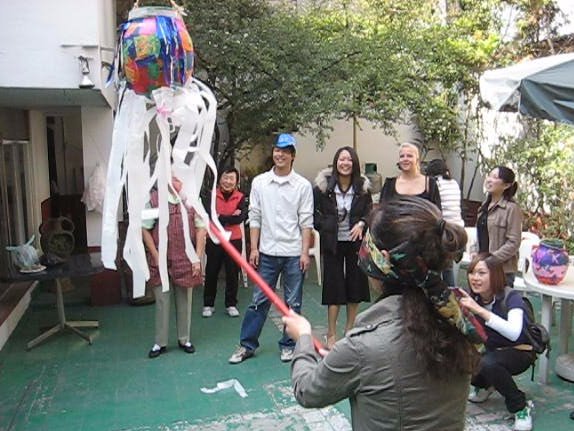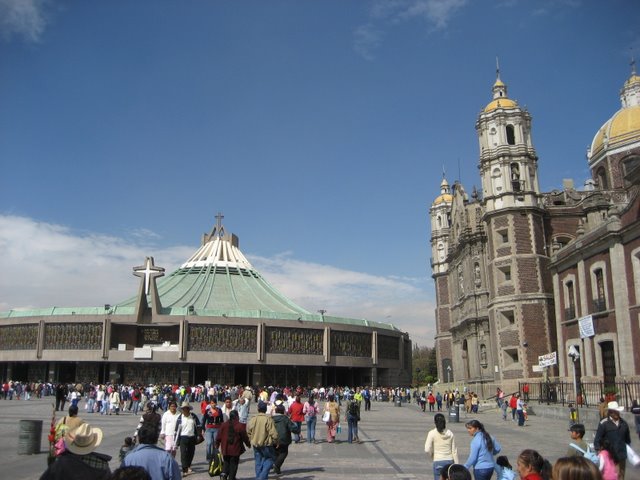|
|
Things To Do
Activities and things to see and do in Mexico City.
By:
Adam
Posted on January 06, 2009 08:02
January 6th is Día de Reyes, or Three Kings Day. It is traditional in Mexico for children to receive gifts on the eve of Día de Reyes, as the baby Jesus was presented with the gifts of the Magi. Gift exchange has historically been more common on this holiday than on Christmas, although the external tradition of giving presents on Christmas is slowly creeping in to Mexican culture.
The other major tradition with this holiday is the Rosca de Reyes, a round (or more oval in these days, to better fit on baking sheets or in boxes) cake made of sugared sweet bread and decorated with candied fruits. It is also common to fill them with whipped cream. Friends, family and co-workers gather to share the cake. Each person cuts a slice in turn. Inside each Rosca de Reyes is one or more baby Jesus' made of plastic. The tradition goes, if the slice of cake you cut for yourself contains the baby Jesus, you will be blessed for the year! -- Also, you get stuck with bringing tamales and atole to share with the group on February 2nd, El Día de la Candelaria! Happy eating and good luck!
Continue Reading: Feliz Dia de Reyes - Let's Eat Cake!
By:
Adam
Posted on December 19, 2008 21:11
Here's an interesting article from the AP on some the trendy hot spots here in Mexico City, and talks about a few cool things to do, like the Turibus, and mentions some of the chic neighborhoods, or colonias. It even mentions our schools very own Colonia Roma. Que Padre!
While I think they embellish a bit on the pick-pockets, it is definitely worth a read. From the article:
Move over greasy tacos and tacky trinkets: Mexico City is home to a vast network of chic museums, top-notch restaurants and trendy night clubs. There's even an Icebar. What's more, the city remains one of the globe's best budget stops...
Continue Reading: Article: Mexico City is a chic hot spot for pocos pesos
By:
Adam
Posted on December 17, 2008 20:24
A unique Mexican Christmas custom is Las Posadas (The Inns) celebrated the 9 days prior to Christmas, December 16th through the 24th. Las Posadas is celebrated to remember the struggles of Mary and Joseph as they tried to find lodging in Bethlehem. The 9 nights of the celebration signify the nine days they Mary and Joseph traveled to reach Bethlehem from Jerusalem.
 Traditionally, friends, family or neighbors will gather at the house of a different host each of the 9 nights to sing hymns and eat tamales with hot drinks, such as atole or ponche. The highlight of the evening is the singing of the traditional Posadas hymn, sung in a call and response fashion, where the hosts, acting as the innkeepers, sing from within the closed door of their house, and the guests stand outside the room and sing the verses of Joseph and Mary asking to stay at the inn. At the end of the song, the innkeepers open the doors to give room to Mary and Joseph.
Traditionally, friends, family or neighbors will gather at the house of a different host each of the 9 nights to sing hymns and eat tamales with hot drinks, such as atole or ponche. The highlight of the evening is the singing of the traditional Posadas hymn, sung in a call and response fashion, where the hosts, acting as the innkeepers, sing from within the closed door of their house, and the guests stand outside the room and sing the verses of Joseph and Mary asking to stay at the inn. At the end of the song, the innkeepers open the doors to give room to Mary and Joseph.
Afterward, snacks and drinks are usually provided, and one or more piñatas are broken by the children and guests.
Las Posadas Fiesta at the Spanish School
We always like to treat our students to a Posadas fiesta on the last day of classes prior to the Christmas break. Students make traditional piñatas by decorating clay pots, or canteros, with paint and colored paper. The pots are then filled with candy and, of course, broken!
Continue Reading: Celebrating Las Posadas in Mexico City
By:
Adam
Posted on December 12, 2008 01:20
December 12th is the feast day of the Virgin of Guadalupe, and attracts millions of pilgrims to the Basilica in Northern Mexico City where the image of the Virgin Mary is displayed.
History
As the story goes, in December of 1531, peasant farmer Juan Diego encountered a vision of the Virgin Mary while walking on a hill in Northern Mexico City. The apparition told Juan Diego to build a church in her honor on that site. When Juan Diego informed the local Bishop of this, the Bishop asked for proof. So Juan Diego returned to the hill where Mary told him to pick the roses growing on the hillside, which were of a variety native to Spain, and out of season, to boot. Juan Diego gathered the roses in his Tilma, (a large cloth worn by men at the time and also used as a satchel) to take to the Bishop.
Upon returning to the Bishop, he presented the roses only to find that they had been miraculously replaced by an image of the Virgin that was painted on the cloth. That did it for the Bishop, who ordered the construction of the Basilica, which is still standing (barely) today at the foot of the hill where Juan Diego first saw the vision.

The Basilica
The image of the Virgin has since been moved to a newer Basilica (shown left), also called La Villa de Guadalupe, which was constructed in the mid 1970s, right next to the original. The new Basilica holds 10,000 plus, and is the second most visited Catholic site outside of the Vatican. Visitors can view the Virgin up close, which is on display behind the altar, by riding rows of moving sidewalks situated directly underneath the image.
Visiting the Basilica
Getting to the Basilica is relatively easy, so long as you don't try it any time in December up through the first week of January. The feast day of the Virgin of Guadalupe being on December 12, complied with the proximity to Christmas, results in millions of visitors during this time. Streets are shut down as well as several bus routes and any Metro stations that are close by. Many pilgrims can be seen walking with images or statues of the virgins, as well as crawling on their knees along the thoroughfares leading to the Basilica.
To any of our Spanish students who ask about visiting the Basilica during December, we say, Don't! If possible, it is best to wait to go during another part of the year, when it is less crowded. Normally, you can take the metro to La Villa station, or any bus running along Reforma or in the Centro that says 'La Villa' or 'Basilica' in the bus window.
Expressions and Traditions
Guadalupano is one who follows or believes in the Virgin of Guadalupe. An interesting part of the Mexican culture and religion is that while a person may not consider themselves religious, they may call themselves a Guadalupano, or follower of the Virgin.
Lupe, Lupita, Lupito are all nicknames of someone who may be actually named Guadalupe, or their family may have specified the Virgin as their Patron Saint, or they may have even been born on December 12th (like yours truly). In many cases, regardless of who your Patron Saint is, their feast day can be considered a second birthday. So, to all who were born on the 12th of any month or if your Patron Saint is La Virgin, ¡Feliz día de santo!
Continue Reading: December 12th - Virgin of Guadalupe Day